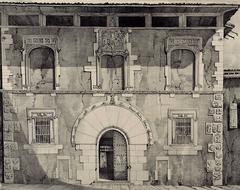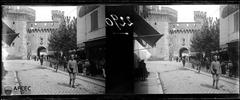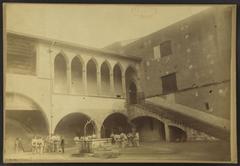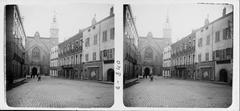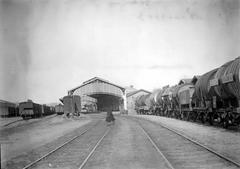Visiting Rue Pierre de Ronsard: Ticket Information, Visiting Hours, and Nearby Historical Sites
Date: 01/08/2024
Introduction
Nestled in the heart of Perpignan, France, Rue Pierre de Ronsard is a captivating street that offers a rich tapestry of history, culture, and architectural beauty. Named after the illustrious French Renaissance poet Pierre de Ronsard, this street serves as a living museum, encapsulating the various historical epochs that have shaped Perpignan. The city itself, located in the southern part of France, boasts a heritage that dates back to Roman times and has evolved through medieval, Renaissance, and modern periods. Rue Pierre de Ronsard is a microcosm of this historical evolution, making it a must-visit destination for history enthusiasts, cultural explorers, and casual travelers alike. The street is not just a pathway but a journey through time, offering insights into Perpignan’s medieval fortifications, Renaissance artistry, and modern-day significance (Europe Up Close, Britannica).
Table of Contents
- Introduction
- Historical Background
- Practical Visitor Information
- Nearby Attractions
- Cultural Significance
- Preservation Efforts
- Conclusion
- FAQs
Historical Background
Origins and Early History
Perpignan, located in the southern part of France, boasts a history that dates back to Roman times. The medieval town was founded around the 10th century and has evolved into a city of significant historical and cultural importance (Britannica). Rue Pierre de Ronsard, situated in this historically rich city, is named after the famous French Renaissance poet Pierre de Ronsard, who lived in the 16th century. The street is emblematic of Perpignan’s blend of historical eras, from its medieval roots to its Renaissance influences.
Medieval Period
During the medieval period, Perpignan was a fortified town, serving as the capital of the counts of Roussillon. In 1172, it passed to the house of Aragon, and James I of Aragon later divided his realm, leaving Roussillon and Majorca to his younger son, James II, who made Perpignan the capital of the Kingdom of Majorca from 1276 to 1344 (Britannica). This period saw the construction of many significant buildings, including the Perpignan Cathedral and the Castillet, which are still standing today and contribute to the historical ambiance of Rue Pierre de Ronsard.
Renaissance and Baroque Influences
The Renaissance period brought a wave of cultural and architectural changes to Perpignan. The city became French in 1659 by the Treaty of the Pyrenees, marking the end of the struggle between France and Spain for the province of Roussillon (Britannica). This era saw the influence of Baroque art, exemplified by the works of Hyacinthe Rigaud, a native of Perpignan. The Rigaud Museum, located nearby on Rue de l’Ange, houses many of his works and those of other Catalan artists (Europe Up Close).
17th and 18th Centuries
In the 17th and 18th centuries, Perpignan continued to develop as a fortified city. The bastions of the great citadel from this period still surround the partially restored medieval palace of the kings of Majorca (Britannica). Rue Pierre de Ronsard, like many streets in Perpignan, reflects this historical layering, with buildings and structures that showcase the architectural styles and urban planning of these centuries.
Modern Era and Preservation
The 19th century saw significant changes in Perpignan, including the dismantling of the town walls. However, the picturesque Castillet, a 14th- and 15th-century crenellated fort that defended the principal gate, still stands and now serves as a museum (Britannica). Rue Pierre de Ronsard, while modernized, retains its historical charm, with many buildings preserved to reflect their historical significance.
Practical Visitor Information
Visiting Hours and Tickets
While Rue Pierre de Ronsard itself is a public street and accessible 24/7, many of the historical buildings and museums nearby have specific visiting hours. For instance, the Castillet Museum is open from Tuesday to Sunday, typically from 10 AM to 6 PM. Ticket prices vary, with discounts available for students and seniors. It’s advisable to check the official websites for the latest information on visiting hours and ticket prices.
Travel Tips
Perpignan is well-connected by public transportation, making it easy to reach Rue Pierre de Ronsard. The city’s main train station, Gare de Perpignan, is a short walk or bus ride away. For those driving, there are several parking options nearby. Comfortable walking shoes are recommended as the cobblestone streets can be uneven.
Nearby Attractions
Perpignan Cathedral
A Gothic masterpiece, the Perpignan Cathedral, situated near Rue Pierre de Ronsard, was begun in 1324 and completed in the following century (Europe Up Close). Its stunning architecture and historical significance make it a must-visit site.
The Castillet
The Castillet, with its hexagonal watchtower built in 1368, is another architectural highlight that adds to the historical ambiance of the area. It now serves as a museum, offering insights into the city’s past.
Cultural Significance
Rue Pierre de Ronsard is not just a street but a living museum that offers a glimpse into the rich cultural and historical heritage of Perpignan. The street is a testament to the city’s evolution from a medieval stronghold to a Renaissance cultural hub and a modern administrative center. Visitors walking down Rue Pierre de Ronsard can experience the layers of history that have shaped Perpignan, from its Roman roots to its medieval fortifications and Renaissance artistry.
Preservation Efforts
Efforts to preserve the historical integrity of Rue Pierre de Ronsard and its surrounding areas are ongoing. The city of Perpignan has implemented various measures to maintain its historical sites and buildings, ensuring that they remain accessible and informative for future generations. The preservation of these sites not only honors the city’s rich history but also enhances its appeal as a tourist destination.
Conclusion
Rue Pierre de Ronsard in Perpignan is a microcosm of the city’s historical and cultural evolution. From its medieval origins to its Renaissance influences and modern-day significance, the street offers a unique and immersive experience for visitors. By exploring Rue Pierre de Ronsard, tourists can gain a deeper understanding of Perpignan’s rich heritage and the historical events that have shaped this fascinating city (Culture Trip, Britannica).
FAQs
What are the visiting hours for Rue Pierre de Ronsard?
Rue Pierre de Ronsard itself is accessible 24/7, but nearby historical sites like the Castillet Museum have specific visiting hours, typically from 10 AM to 6 PM, Tuesday to Sunday.
Are there any ticket requirements?
While walking along Rue Pierre de Ronsard is free, certain museums and historical sites nearby may require tickets. It’s best to check their official websites for the latest ticket prices and discounts.
What are some nearby attractions?
Nearby attractions include the Perpignan Cathedral and the Castillet, both of which offer rich historical insights and stunning architecture.
How can I get to Rue Pierre de Ronsard?
Perpignan is well-connected by public transportation. The main train station, Gare de Perpignan, is easily accessible by bus or on foot. For those driving, several parking options are available nearby.
References
- Europe Up Close, 2023, Europe Up Close
- Britannica, 2023, Britannica
- Culture Trip, 2023, Culture Trip

